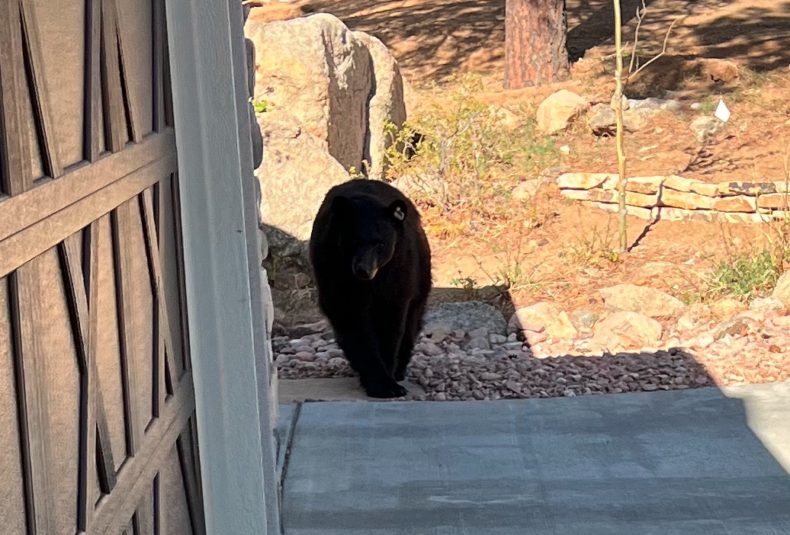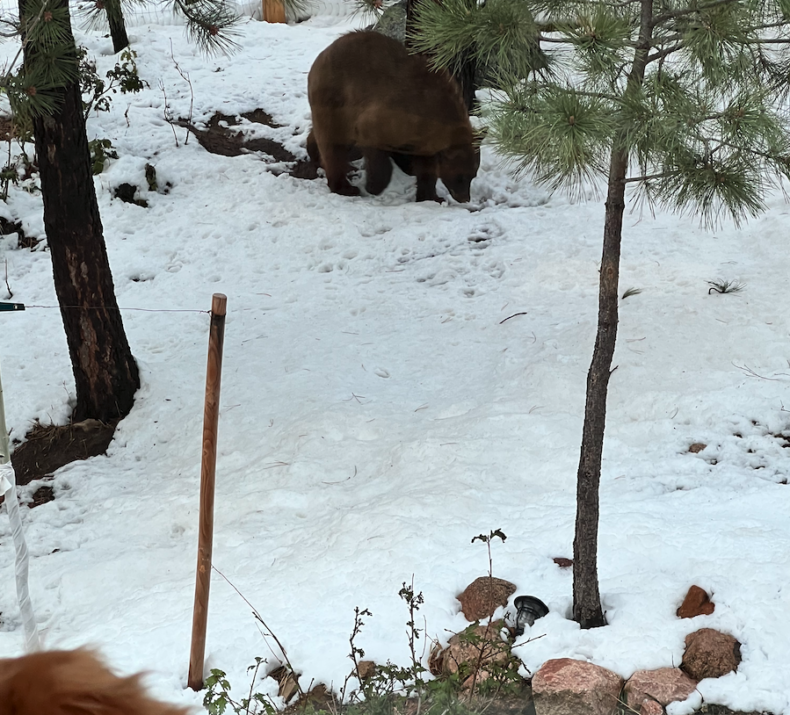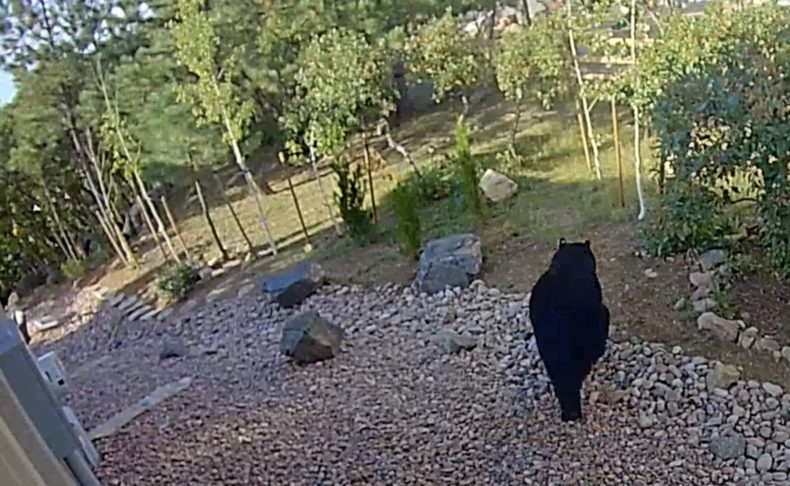
Last week, I was wiping up crumbs when brown motion out the window caught my peripheral vision. It was not random. It was deliberate, but quick, and it was dark. It was not my dog, because she was under the high chair seeking the crumbs I was wiping. It was not my neighbor’s dog, who always gets out, because it was way too big. It was not Deuce, the double-tagged black bear we see often. It was the Big One, a bear we somehow haven’t yet named—a huge, rotund specimen with a single ear tag and a surprisingly spry gait for its size.
It was gone through the trees before I had a chance to grab my phone and snap a photo, but the security camera caught it. It was going fast enough to have been spooked by something, probably a car. It passed my kitchen window at 8:33 a.m., which I deem far too late for a gigantic bear to be sauntering across the same strip of grass where my toddler likes to pretend to hike. (The above photo, from June, was taken around 9 a.m.)
I have lived among the bears for nearly three years now, and they still blow me away. I will never get used to their presence, which is nearly constant, according to the Ring cameras we installed and according to my own eyes, which catch them practically any time of day, during any mundane task. Sometimes I see a forepaw moving behind the pines; sometimes it’s a rump and a nubby tail, gone before I have truly registered what I’m seeing.
I live in a healthy forest, or more accurately a healthy wildland-urban interface. We have bobcats, at least two, which have been caught on camera in the act of killing a rabbit and using my coconut coir doormat as a scratch pad. We have skunks, rabbits, raccoons, Norway rats, shrews, eastern fence lizards, magpies, Steller’s jays, red-tailed hawks, broad-tailed hummingbirds, ravens, peregrine falcons, kestrels, great horned owls, Western tanagers, and at least one mountain lion. I try to notice them all and to know their names, but I admit many of these creatures have become part of the background noise of my daily life. (I know this is absurd and I am spoiled.) The resident mule deer snap me to attention, too, and sometimes (rarely) I’m distracted by the large rafter of turkeys that lives beside me. But the bears get me every time. They are still so incongruent, despite my having moved into their habitat. Their presence mere feet from my door is still so abnormal that it takes very little for me to notice them, and for my limbic system to raise the alarm.

Humans are very good at recognizing things that are out of the ordinary, like the bears in my backyard. We are better than computers at picking out blips in a pattern, at finding signals in the noise. Some scientists have forged careers out of this recognition of our superior recognition. Human volunteers have been tapped to look for patterns in data as multivariate as old shipping logs; images of galaxies; starlight being blocked by orbiting planets; even the intricate folding of amino acid chains that make up complex proteins.
I wondered about my ability to sense Big One so assuredly. It was kind of incredible, really: I was cleaning the kitchen, talking to my toddler, nudging my dog out of the way, thinking about deadlines. Despite all this inner noise, the tiniest sensory input sparked my full attention. I started reading some of the literature on the brain, because that is a thing I would do.
I learned that motion perception is one of humankind’s greatest strengths. It seems to be one of the most complex forms of cognition, because it relies on so many competing signals from so many competing sources. Perceiving motion apparently relies on at least three systems in the brain. The visual, vestibular and proprioceptive systems all play a role in understanding where your own body is in space; where another thing is located and whether it is moving; how you and the thing are moving relative to the background landscape (which might also be moving, like in the wind); and how these things relate to one another. On top of that, you have to figure out what the thing is and what it’s doing and where you are and what you’re doing. It’s a lot. Information from just one of these perception systems is not enough, so we need multiples; but, unfairly, when you put them all together, sometimes they are in conflict. Your brain has to sort out all the inputs from all these systems of perception to figure out what you are really seeing, understand what it is, and respond accordingly. Immediately, to save your own skin. Even very advanced artificial intelligence systems still struggle with this, which I did not find surprising.
This seems like an obvious adaptive advantage. Our ancestors would have been able to protect themselves and their offspring more quickly by noticing immediately a slight change in the shadow, a movement in the grass, a color that shifted in the environment in a way that wasn’t expected. I was very intrigued that in vertebrates, which are all of us, motion sensing takes place in a special type of cell in our eyes called retinal ganglion cells. These are neurons that basically offer a direct line of visual input to the brain, and are important for all sorts of reasons.
In 2022, in the WUI, I’m not totally sure what to make of my ability to immediately detect a bear. I have a toddler and an older child, and their presence surely supercharges the system responsible for detecting danger, pumping up adrenaline and activating my fight-or-fight response. I’m sure there is some biochemical explanation that would make perfectly reasonable sense. But after perusing some scientific papers on this, I am content to just …. like it. I moved to the home of the black bears, and they didn’t leave, so maybe I am ok, to them. They don’t mind me. They might look for my garbage, but they don’t care about me. They probably don’t even want me to notice them as they go about their day and I go about mine.
But I do. And I hope I always will.

I love this. I also somewhat envy you–we get one bear coming through Princeton every couple of years. I’ve never seen it, and I want to! Whether I’d be OK with having them around all the time is another question, of course.